 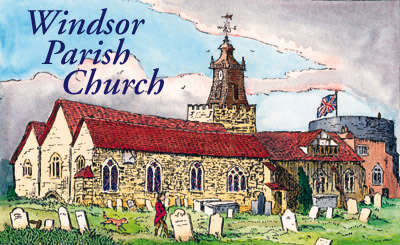
|
|||
 
|
|||
|
Parish Church Restoration |
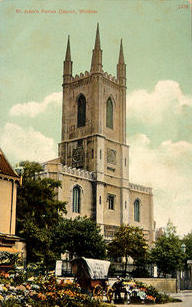 |
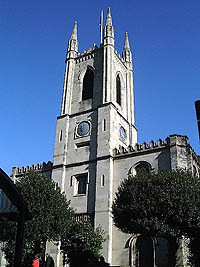 |
The present building dates from 1822 when
it replaced an ancient building which had Saxon arches and Norman
work. The present walls follow the plan of that mediaeval church
and old vaults lie beneath the present floor, while many old
memorials were retained and positioned upon the present walls.
The ancient Church of St, John the Baptist, New Windsor,
must have arisen soon after Henry I moved the Royal Court to
the Castle site from Old Windsor (c.1110). Reference to it by
Henry II clearly establishes that by 1184 the church had been
in existence for some time, and had had previous incumbents.
By the 18th century the church was a "vast building
with 10 side altars and several chantries". In 1818 the
high cost of repairs to the old building brought forward plans
for a complete rebuild at a cost of £14,000. Between 1820
- 1822 the new building was erected with Charles Hollis as architect.
Cast iron columns and ribs support a 84' x 60' roof. It was consecrated
on June 22 1822 by the Bishop of Salisbury.
In 1870 the Chancel and Apse were
added by the noted church architect Samuel S. Teulon. H.R.H.
Princess Christian and 70 clergy attended the opening. The Chancel
Screen was added in 1898 - a thanks offering for the 60 years
of Queen Victoria.
To the right side of the main steps from the High Street is the stone and replica "lion and floriated cross" matrice to Idonea de Audele, Abbess of Burnham (1314-1324) who was originally buried in the old building near to the present pulpit.
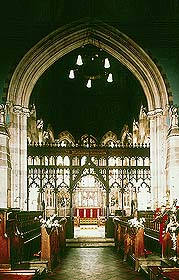
The matrice design can be seen again in
the main Glass Doors which form, with side panels, the Royal
Borough's War Memorial to the fallen of the 1939-45 War. On the
left wall is a fine Doric style memorial made by Edward Marshall
to Mrs. Paget (née Nazareth Harris) who died in 1666.
On the opposite wall is a bust in an architectural frame to a
young man, Topham Foote (Foot), (d.1712). The monument is an
early vork of Peeter Gaspar Scheemakers (1691-1781), who sculpted
busts of Shakespeare, Pope, Dryden and other memorials in Westminster
Abbey. [Genealogy
Info on Samuel Foote and his son Topham Foote / Foot of Windsor]
Nave (turn right)
On the West Wall is a grey marble memorial
to John Woodruff, (1669-1728), mason to Lord Weymouth of Old
Windsor, and in the south aisle (past the doors) a memorial to
Mrs. Margaret Woodruff (1735-1805) a "spinster", the
'Mrs' a courtesy title to a person of some distinction.
South Wall (turn left)
Centrally is a fine window showing Archangel
Gabriel and Mary at the Annunciation. It marks the Diamond Jubilee
(1875-1935 ) of the Girls' Friendly Society.
Mid-south wall. Various tablets including one to William Heberden
(1767-1845), Physician to George III.
Windows. Showing King David as a lyrist and St. Cecilia
at the organ, with part of the Castle, and a tree representing
the Park are in memory of Alderman Thomas Dyson, Mayor, 1890,
and family, who have provided several Mayors of Windsor in the
20th century.
Under glass.
A piece of mediaeval wall to Guardsman
Harry Bigge (1514). The memorial ends "...Harry of the Gard
sutyme was me and died ye ffiefte day of September trewly the
fyffte yeyrre of, Eighte Hary ffor whose sowles of yor charrite
say a pat. nost we ave. "
Another nearby stone memorial under glass is from 1509 to Mayor Wyllima Canon "sumtime major of
Windesne and Elizabeth his wife ..." Brass to Jas. Ellison,
M.D. (1817-1897) Kinsman of two vicars of Windsor.
Rev. Isaac Gossett (1783-1855) who trained Bishop Selwyn. Below it is a fine Jacobean marble memorial (1605) showing the kneeling figures of Edward and Elynor Jobson and their 6 sons (one between the parents, a baby) and 4 daughters.
Note the painting of Windsor Parish Church
about 1760 by Margaret Yardley, A.R.C.A. The artist captures
the scene as parson and people set out to "beat the bounds"
of the parish. Scene and costume are authentic.
The nearby portraits of vicars shows the more recent
of the known 61 incumbents and covers the period of the present
building 1821 - 1972. It also includes a fine portrait of one
of our famous curates the Rev. G. Augustus Selwyn 1833 -1841
who became the first Bishop of New Zealand 1841 - 1867, and then
of Lichfield 1867 - 78. He founded the Melanesian Mission, and
has Selwyn College, Cambridge, named after him. Another curate,
the Rev. J. S. Stone, (1862 - 1870), wrote the famous hymn 'The
Church's One Foundation' (1866 ) and some 60 others.
Turn right past the Brass Lectern (1882) in memory
of Jas. Griffin, Churchwarden, into the choir stalls. Theorgan
is a splendid 3 manual and pedal instrument by A. Hunter and
Son, revoiced in 1936. It has 57 stops and 20 pistons and couplers,
and about 3,000 speaking pipes, capable of literally millions
of sounds. Between the organ and the Screen is a brass memorial
to Canon James Ellison, Vicar 1855-1875
and founder of the Church of England Temperance Society. His
son James followed him as Vicar, 1895 - 1913. On the opposite
side is the hatchment of Richard Galis, Host of the Garter Inn,
(d. 1580). Galis was 5 times Mayor of the town and Shakespeare
drew on his local knowledge of scenes and personalities for his
play "The Merry Wives of Windsor."
Beyond the Chancel Screen (1898)
is Teulon's beautiful Chancel and Apse (1870) . A fine choir
of sculptured half angels with musical instruments and 6 full
length figures of angels surmount the twisted columns of the
reredos. The latter is set with mosaics by Antonio Salviati (1816
- 90), who adorned The Altar of Westminster Abbey. Adoring angels flank the Lamb with flag, and a
pelican feeding its young, symbols of Humility and Sacrifice.
Above there are the instruments of
the Passion.
The 5 East Windows (from left to right)
illustrate Christ's teaching on the Last Judgement. (MT.25, 35-40)
by reference to the treatment by religious people of the (i)
hungry (ii ) strangers (iii ) sick (iv) destitute and (v) imprisoned.
The Royal Pew (or Frogmore Pew) is situated on the
south side of the Sanctuary. The 2 'thrones' within the pew were
the gift of Princess Augusta (daughter of George III) who was
a regular worshipper here while she lived at Frogmore. The pew
was also used for Sunday worship by King George V and Queen Mary when they were living at Frogmore
as Prince and Princess of Wales (1901-1910). The pew was last
regularly used by the late Prince George, Duke of Kent who was
killed in an air accident during World War II. The pew is fronted
by a low screen containing panels carved by Grinling Glbbons
(1648-1720) each showing a pelican feeding its
young. From 1680-1788 it formed part of the altar rail in St.
George's Chapel. George III gave it to this church. Note Gibbons'
peapod signature (bottom left).
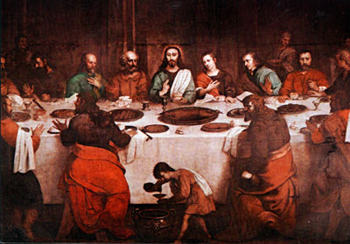
From the Lectern, look down the centre
aisle and observe in the West Gallery a painting of The Last Supper. This is a national treasure. The picture was
originally presented to the Royal Chapel c. 1660 by Brian Duppa,
Bishop of Winchester, Prelate of the Order of the Garter. It
was "bought by him beyond the sea". Another tradition
ascribes it to Franz de Cleyn (1588-1658), Rostock, Mecklenburg,
Court painter to James I. It was rolled up and buried "in
the plumery" (plumbers workshop?) in the Great Rebellion.
It hung over the altar at St George's, Windsor in 1702, and can
be seen there in Sandby's drawing dated 1786.
Following alterations at St. George's
in the 19th century, it was given to the Parish Church by George
III and hung over our altar (the church then ended at the Chancel
Screen) until 1870, when the Teulon apse meant that the painting
had to be hung in the West Gallery. As our altar piece it was
set off by the Grinling Gibbons' altar rail, as had been the
composition previously in the Royal Chapel.
The picture measures 15' x 14'.
One has the impression of actually looking into The Upper Room.
The table is laid with the Passover fare. Deep emotion storms
through the figures. Judas in the foreground, is torn with stress
and indecision. By contrast the Saviour is calm and radiant,
dominating the scene. His hand is lifted in blessing as He holds
the Bread. We are witnessing the Institution of the Holy Communion.
The dwarf (wine steward) is typical of Florentine Court paintings
of the period.
Midway down the Centre Aisle are
wide pews reserved for Alderman and Councillors, while the Mayor's
pew bears the Royal Arms of the Borough and a cushion for the
mayoral mace.
North Aisle (turn right)
Past the pulpit and side altar, noting white and gold altar frontal designed by Margaret Yardley, ARC. In the North Aisle itself there is a succession of 18th and 19th century memorials commemorating local worthies, and a window which commemorates Jesus with Martha and Mary of Bethany with the remainder of the better choice made by the latter.
On Easter Day 1906, the present organ installed by Hunter and Sons, was opened, C.H. Lloyd, Precentor of Eton College giving the opening recital. To allow for its installation both side galleries were reduced in length and to accommodate new choir stalls (west of the screen ) a large number of pews were removed.
You would be very welcome |